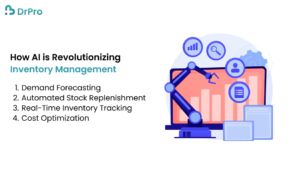Quick Summary
The use of such technology in the organization’s inventory management has been embraced by many companies across various industries. This paper aims to examine how An AI-driven inventory management system, demand planning, and stock replenishment, enhance efficiency and reduce costs.
Introduction
An AI-driven inventory management system of inventories is often seen as the foundation of the efficient operation of any company. Inventory Control Systems(SCOF) are increasingly being used in manufacturing and retailing industries as tools to monitor, control, and manage their stocks. Nonetheless, conventional systems rarely have a problem accommodating emerging business complications. This is where artificial intelligence enters and disrupts the field making the solutions smarter and way more flexible.
AI, therefore, assists businesses not only in stock-keeping but also in demand forecasting, tracking, and other automation of crucial tasks. This change is revolutionizing how many organizations manage their inventories, putting them at an advantage through the elimination of human errors and enhancing decision-making processes. In this article, you will understand how, with the help of AI, inventory is changing and why it enjoys such huge popularity among enterprises.
What is an AI-Driven Inventory Management System?
An AI-driven inventory management system is, therefore, a development of a conventional inventory control system, which embraces the use of artificial intelligence. Inventory management is achieved through employing artificial intelligence algorithms that manage the stocks and analyze the data as well as forecasting future trends. These systems merely complement manual processes as they help to automate multiple calculations and optimize the procedure of stock replenishment required for inventory control.
Attributes of an AI-driven inventory management system; real-time tracking of stocks, automation of analysis of future trends, automatic restocking, and compatibility with existing business systems. These capabilities assist the firms to better satisfy customer demand and reduce variability, which translates to less waste and no stock-outs.
How AI is Revolutionizing Inventory Management

1. Demand Forecasting
Another area I believe that AI to inventory management to inventory management has made the biggest impact in regards to inventory management is the accurate prediction of demand. An AI-driven inventory management system usually has historical data where using big data analytics it controls and learns about customer demand and thus can make better predictions. This assists a business in stocking the right products at various times to avoid the occurrence of overstocking or understocking.
For instance, the companies whose operating cycle is affected by seasonal variations such as shops can apply AI to manage their stocks about demand estimation. An AI-driven inventory management system can greatly help organizations in managing an organization’s stocks about the consumer demands hence reducing shortages Therefore, AI-driven inventory can help organizations in managing an organization’s stocks about the consumer demands hence reducing shortages.
2. Automated Stock Replenishment
Besides changing the way availability is determined an AI-driven inventory management system is also capable of automating the stock restocking process. These systems track inventory stock levels online and replenish them when they get to certain defined levels. This process reduces the involvement of personnel and guarantees that the stock is always at its correct minimum.
Automated replenishment helps customers to avoid stockouts hence businesses do not incidiously slip through the windows by not selling their products. It also assists in avoiding having stocks that take up the working capital and get expensive to store. The employment of AI systems allows trading companies to stock minimal quantities of inventory while still meeting customer needs.
3. Real-Time Inventory Tracking
Inventory in particular can be tracked in real-time with the help of AI. In an AI-driven inventory management system scheme of work, every inventory management transaction is well captured and updated thereby availing sufficient information to a business firm regarding their inventory. This real-time data means that those making decisions can act at a moment’s notice when trends begin or there are concerns such as stock differences.
This continuous monitoring enables businesses to do the following; center supply chain management. For example, in the event of a recall or frequent customer returns, it is possible to locate the implicated stock in a short time to initiate the recall without delay.
4. Cost Optimization
Implementing an AI-driven inventory management system is cost-saving. AI algorithms enable businesses to cut wasteful inventory, limit holding costs, and enhance cash flow position by making acquisitions only required. The role of human factors can also be eliminated in managing business inventories which usually causes some losses in stock.
Moreover, AI helps in decision-making in storage and logistics by eliminating unnecessary overall space needed for new warehouses and excessive spending on transportation.
The Benefits of AI in Inventory Management Systems

1. Improved Accuracy
An AI-driven inventory management system increases efficiency by eradicating errors that are usually characteristic of hand-operated inventory systems. Inaccurate counting, misplaced stock, or wrong entries on a database, AI then makes certain that stock quantities are accurate.
2. Enhanced Decision-Making
Due to artificial intelligence, there are usually accurate analyses and predictions that give a strong foundation and advice on the business choices to be made. This paper established that an AI-driven inventory management system provides managers with the necessary tools that help to track sales trends, customer behavior, and stocks to meet future changes in the market.
3. Increased Efficiency
AI performs mundane tasks that include stock taking, ordering stock, and even predicting demand levels. Such inefficiencies are routine but can be avoided because delegating these time-consuming chores to an AI-driven inventory management system will enhance the time spent оn extraordinaire more productive tasks.
4. Better Customer Satisfaction
Optimal stock levels mean that some businesses can meet such orders on time hence cutting out on-time delivery to the customer. Proper inventory management which is enhanced here by the use of an AI-driven inventory management system is important in ensuring that businesses have their stocks readily available to supply to their customers hence the need to provide a system that best supports this.
5. Scalability
Like most companies, as the business expands, so does the type of inventory required. They do not function well with this type of growth and thus conventional methods of AI-driven inventory management systems fail to meet modern needs adequately. However, with an AI system in place to manage inventory a firm can easily accommodate large datasets and more complex and intuitive forms of stock control without the system collapsing under the pressure.
AI and Supply Chain Integration
The positive effects of AI are not constrained to inventory management but are spread across all segments of the supply chain. An AI-driven inventory management system operates with other business systems including supply and demand systems thus improving the flow of data within an organization. This integration means that it is easy to bring the inventory in alignment with other supply chain strategies.
For example, they foresight disruption on the supply chain, and then they can make changes to the stock. Such measures do not allow one to be always caught off guard by contractors or circumstances, for example, a delay in transportation or lack of suppliers.
AI and Future Trends in Inventory Management
Looking to the future, there are miles of development for AI technologies, and consequently, inventory management as well. Inventory is already being controlled using drones and robotics thanks to AI, and this is enhancing efficiency at the warehouses. Moreover, the use of advanced algorithms of AI is constantly improving and demand forecasting as well as cost optimization is becoming even better.
An AI-driven inventory management system shortly may also include machine learning models for changing the market situation and making decisions on inventory management independently. These advances will take inventory management to the next paradigm of a fully automated system that optimizes itself.
Conclusion
Artificial intelligence is revolutionizing how firms conduct their stock through better inversion systems. The usefulness of demand forecasting automated replenishment, real-time tracking, and cost optimization is almost countless in the use of AI-driven inventory management systems. It now becomes evident that we continue to witness a change in the management of inventories due to the implementation of these technologies by many businesses where AI brings about efficiency and effectiveness together with customer satisfaction.
It is by so doing that one can be able to work on the AI-driven inventory management systems that may in the long run help in shaping better and more competitive supply chain networks in the future.
With ProjectTree and DrPro working together, clients benefit from an integrated solution that bridges the gap between project management and medical practice.
FAQs
Q1. What is an AI-driven inventory management system?
An AI-driven inventory management system leverages artificial intelligence to optimize stock control, automate processes, and predict demand, making inventory management more accurate and efficient.
Q2. How does AI improve demand forecasting?
AI analyzes historical data, identifies patterns, and predicts future demand trends, helping businesses stock products more effectively and avoid overstocking or stockouts.
Q3. What are the benefits of automated stock replenishment?
Automated stock replenishment eliminates manual tasks by automatically reordering stock when levels reach a pre-set threshold, preventing stockouts and overstocking.
Q4. How does AI help reduce costs in inventory management?
AI helps businesses optimize stock levels, reduce holding costs, and improve cash flow by minimizing unnecessary stock and improving accuracy in inventory control.
Q5. What are the future trends in AI-driven inventory management?
Future trends include the use of AI-powered drones and robotics in warehouses and more advanced machine-learning models that autonomously adapt inventory strategies.


